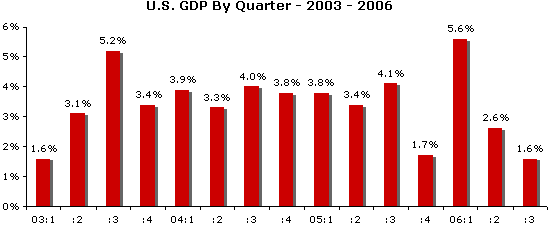IDEX Online Research: Holiday Jewelry Sales to Be Up Moderately in U.S.
November 12, 06
U.S. jewelry sales are projected to rise by 4 percent - 5 percent in the all-important 2006 holiday selling season of November and December. This year, IDEX Online Research is projecting that U.S. holiday jewelry sales will be in the range of $20.3-20.4 billion, up from last year’s $19.5 billion, a gain of about 4.5 percent. This represents an increase in sales of about $28,000 per specialty jewelry store in the U.S., or the equivalent of selling about ten additional diamond engagement rings at the industry-average price of $2,750.
While the jewelry industry’s projected sales gain is expected to be greater than last year’s 3.4 percent increase, most of this year’s sales increase is expected to come from higher prices for jewelry, rather than additional unit sales. It is likely that unit sales of jewelry will be up only modestly during this year’s holiday selling season.
The holiday selling season is a make-or-break period for U.S. jewelers. Retail jewelers in America typically generate about one-third of their annual sales and up to 100 percent of their yearly profits in this two-month period which includes Christmas, Chanukah, and Kwanzaa. Thus, this moderate sales gain, coupled with the prospect of almost no increase in units sold, is expected to put substantial pressure on retail jewelers’ profits, both for the fourth quarter and full year.
IDEX Online Research’s jewelry sales forecast for the U.S. market is as follows:
| 4-5% |
- U.S. jewelry sales will be up in the range of 4-5 percent for the November-December 2006 holiday selling period, with virtually all of the gain coming from inflationary pricing.
- Consensus predictions for total U.S. holiday sales call for gains in the 5-6 percent range, though there is much disparity among forecasts. Because the IDEX Online jewelry sales forecast calls for a smaller gain than the projected increase for all retail categories, jewelers in America are expected to lose share-of-wallet this year.
Few Positive Factors Foreseen
Despite a reasonable sales gain, there are only a few positive factors which will fuel jewelry demand during the holiday selling season, including the following:
- Consumers have jobs and money – The unemployment rate in the U.S. dropped to a very low 4.4 percent in October. It has been five years since unemployment has been at this low level. Further, personal wage gains remain solid. Thus, consumers have plenty of money to spend, and they should be optimistic about the employment outlook.
- Consumer wealth levels are high – Despite a weak housing market, consumers’ net worth – the value of all of their assets including stocks, bonds, homes, and other major assets – are at an all-time high. Consumers, however, say they don’t feel nearly as wealthy as the numbers would indicate.
- Inflationary pricing – For eight of the past ten years, retail prices of jewelry in America have fallen. However, in 2006, due to rising commodity prices – primarily gold, silver, and platinum – retail jewelry prices have risen sharply in the U.S. In recent months, retail prices of jewelry are up nearly 4 percent. Thus, most of our projected 4-5 percent sales increase is expected to come from higher retail prices, rather than increased unit sales. The graph below summarizes the U.S. Consumer Price Index for Jewelry from 1988, including our estimate for 2006.
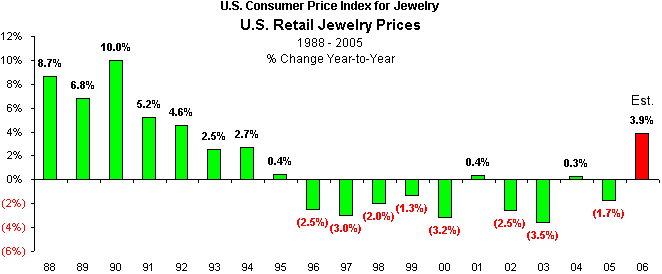 Source: US Dept of Commerce/BLS |
- One extra day in the holiday season could help boost sales – Most forecasters measure the U.S. holiday selling season as the number of days between Thanksgiving (the last Thursday in November) and Christmas (invariably December 25). This year, there will be one more day in that period versus last year. Depending on which forecasting service you talk with, a longer holiday selling season 1) may have no impact on demand; 2) could cause shoppers to procrastinate; or, 3) could be a catalyst to fuel consumers to spend more.
- DTC marketing programs, including Journey diamonds, could provide a boost to diamond jewelry – Most jewelers report that the DTC’s newest marketing concept for the American market – Journey diamonds – has been successful. While this concept alone will not save the season, it could have a materially positive impact on diamond sales. The DTC is spending heavily to help promote diamond jewelry during the holiday selling season this year.
- Post-Christmas period could be a pleasant surprise – The week after Christmas is becoming one of the most important weeks in the holiday selling season. Shoppers are expected to be out in force beginning Tuesday, December 26. As a result, aggregate consumer spending during the final week of December could make it the most important shopping period of the 2006 holiday selling season.
- Jewelry is a “feel-good” product – There is an old saying among American consumers: “When the going gets tough, the tough go shopping.” What do they shop for? Something that makes them feel good – luxury goods such as jewelry.
The graph below summarizes jewelry sales trends during the all-important holiday selling season since 1993. Our forecast for 2006 is also shown on the graph.
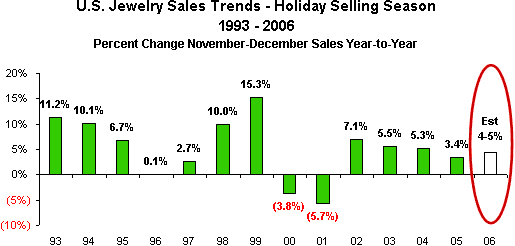
Source: US Dept of Commerce & IDEX Online Research
Negative Factors Are Significant
There are a number of negative factors that will weigh heavily to dampen consumer demand in the U.S. during November and December, including the following:
- Gas pain – Energy prices – gasoline, natural gas, heating oil – are up from last year’s levels. This will put a crimp on consumer spending during the 2006 holiday selling season. The good news, so far, is that consumers have cut back on discretionary purchases of small ticket goods and services such as beer and dining out, rather than spending less on luxury goods. For the first three quarters of 2006, luxury goods spending has remained robust, a trend which is likely to continue through the holiday season. However, the outlook for luxury expenditures in 2007 is cloudy.
- Slowing economic growth – Third quarter U.S. GDP growth was a very modest 1.6 percent, somewhat below consensus expectations. As the graph below illustrates, economic growth has been slowing during the first three quarters of 2006, a trend that will continue well into 2007, based on consensus economic forecasts. Jewelry and diamond demand correlate closely to economic vitality. Typically, jewelry demand slows in advance of an economic slowdown; further, it is one of the last categories to rebound when economic growth accelerates. So far, in 2006, U.S. jewelry demand has remained relatively robust, but the potential for a slowdown, especially in early 2007, is a distinct possibility.
- Consumer debt burden – The consumer debt burden is at a record level. However, household net worth to disposable personal income is also at a high level. Thus, consumer debt levels may not be as burdensome as the numbers would suggest. The risk is that consumers will say, “Enough is enough” and refuse to take on new debt. In fact, the Department of Commerce just announced that non-revolving credit usage fell in September; this does not bode well for the jewelry industry. Since just under 50 percent of all jewelry sold in the U.S. is purchased on the monthly payment plan, consumers’ reticence to take on new debt could have a dramatic negative impact on jewelry demand.
|
|
- Higher interest rates – As interest rates rise, consumer loan activity, especially related to buying big ticket durables, typically begins to slow. Credit card companies find ways to raise the effective interest rates on shoppers who carry long term monthly balances – roughly 55 percent of all American consumers who have a credit card. Higher interest rates also slow business activity which slows new job creation. Finally, higher interest rates typically put a major damper on the housing market, causing home prices to flatten or fall. In addition, consumers with variable rate mortgages are making higher monthly payments as interest rates rise. All of these factors put pressure on consumer spending.
- Low inventory levels among jewelry retailers – Jewelry suppliers and wholesalers say that most American jewelers have curtailed orders over the past several months. Not only have jewelers declined to restock certain goods, but they have delayed their orders for holiday goods. Thus, even if shoppers decide that jewelry is an important item on their gift list, under-stocked jewelers won’t be able to meet demand, and the prevailing attitude among many jewelers that the holiday season will be weak may become a self-fulfilling prophesy.
- Wal-Mart effect – Early discounting coupled with other retailers who are expected to out-promote specialty jewelers will cause jewelry merchants to lose share-of-wallet this year. After announcing flat sales in November, retailing behemoth Wal-Mart has said that it will cut prices to boost sales during the holiday selling season. While some retail analysts suggest that Wal-Mart is bluffing, the publicity surrounding this announcement will give shoppers one more reason to delay their purchases until all items on their gift list have been reduced in price. Every year, shoppers and merchants wait to see who blinks first in the game of “price discounting”; every year, the consumer wins, and this year will be no different.
- Impact of online shopping will be significant – In 2005, online jewelry sales were about 3.5 percent of total jewelry sales; this is well above the level of 2.3 percent for all retail categories. In part, this is due to the high mix of online diamond sales. However, online retailers such as Blue Nile and others have added fashion jewelry to their line; this could further boost online jewelry market share. Some analysts suggest that online sales will also increase as consumers attempt to save money be eliminating a trip to the mall in their gas-guzzling SUV.
- Monday Christmas will hurt – While there is one extra day in this year’s holiday selling season, the potential positive impact of that extra day will be more than offset – negatively – by a Monday Christmas. When Christmas falls on Monday, shoppers typically finish their shopping on Saturday, and sit-out Sunday with a variety of non-shopping experiences including family gatherings, church, and other seasonal social events. Culturally, Sunday is a “day of rest” for most Americans, sales expectations for December 24, often a major shopping day, call for modest sales levels this year.
- Unfavorable jewelry industry publicity – America is the land of political correctness, and some social activists seek to find rallying points by grasping at any issue that will garner media attention. Despite the fact that the diamond and jewelry industry has cleaned up its act, activists appear to have targeted the industry once again, just as the holiday selling season heats up. Frankly, we think the threat of unfavorable diamond and jewelry industry publicity is overblown. However, it is possible that there could be some negative impact from an unfavorable movie as well as demonstrations in a few major markets. Its weighting in our forecast model was a “neutral.”
Christmas Always Comes
Despite the negative tone of the market going into the holiday selling season, Christmas always comes. There is another American adage: Baseball may be this country’s national pastime, but shopping is its passion. That’s why they are called “consumers” and “shoppers.” Americans invented recreational shopping. People will be in the malls. It is up to retail jewelers to provide the opportunity for those shoppers to spend their money on jewelry versus some other merchandise.
Outlook for 2007: Challenging
Based on the relatively high correlation between economic growth and jewelry demand, we believe that jewelry sales in the U.S. will be under pressure in 2007. Consensus economic forecasts call for the U.S. economy to slow in 2007, but not fall into a recession. Based on historical trends, jewelry demand will likely weaken just after the holiday selling season, and may not begin to recover until near the end of 2007. The graph below illustrates GDP growth – including consensus forecasts – from 1990 to 2008.
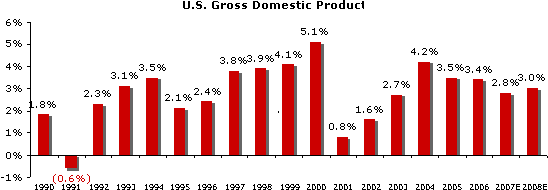 Source: US Dept of Commerce & IDEX Online Research |
Consensus global economic growth forecast mirror U.S. economic growth, as the graph below illustrates.
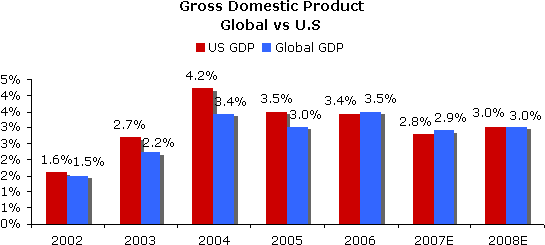
Source: US Dept of Commerce & IDEX Online Research
The IDEX Online Research forecast for jewelry sales for the next several years is summarized below. While we are forecasting a modest increase in jewelry sales in 2007, virtually all of the increase will come from inflationary pricing, in our opinion.
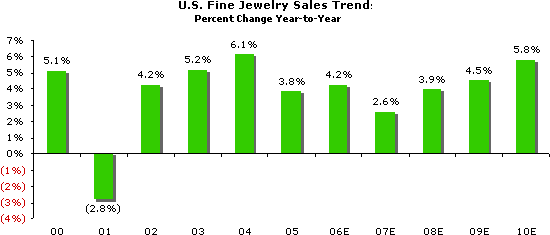
Source: IDEX Online Research
